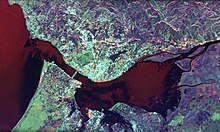Inverted river delta
River deltas typically form on flat, coastal floodplains: the narrow end located at the point where a river fans out and deposits sediment in a region extending outward into the body of water which the river empties.
The sediment is dropped within the valley and the clear water then exits into a bay or the ocean, so the apex of the delta is at this exit, a configuration said to be inverted from that usually seen.
Inverted deltas typically do not last long in geological terms, since they tend to fill up with sediments rather quickly and eventually become normal deltas[citation needed].
[1] The water from the rivers that drain the entire, large California Central Valley exit through the Carquinez Strait, a narrow gap in the Coast Range.
It is still about 15 km (9.3 mi) wide and 25 km (15.5 mi) long, compared with the 2 km-wide (1.2 mi) exit into the sea, and forms a large lagoon with large and very shallow sand banks which are uncovered during low tides.


